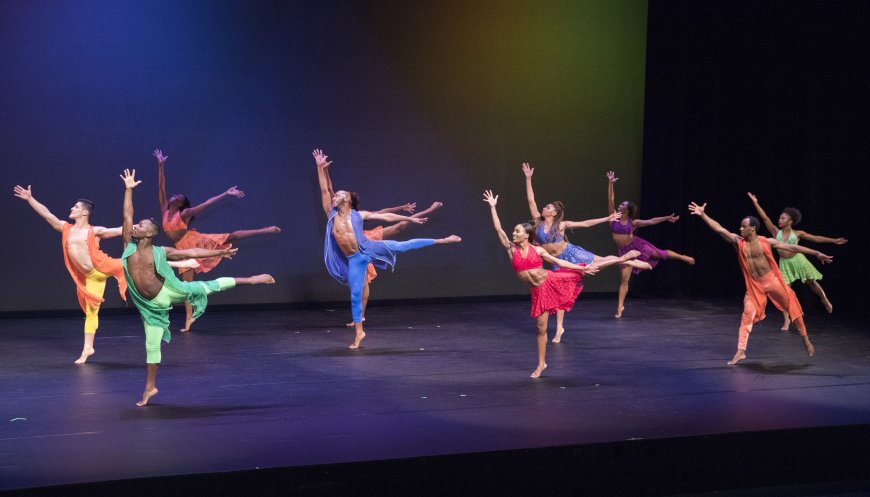
It’s not every day that nearly 100 Los Angeles students and dancers have the opportunity to work with members of the Martha Graham Dance Company. But that’s precisely what will happen on April 26 when the Younes and Soraya Nazarian Center for the Performing Arts at Cal State Northridge presents “LA Dances Graham100,” closing out the venue’s newest initiative, LA Seen, with a terpsichorean bang.
That monthlong festival, dedicated to shining a spotlight on the performing arts in the City of Angels, will conclude with soloists from the Graham company, Los Angeles-based Lula Washington Dance Theatre (LWDT), the USC Glorya Kaufman School of Dance, CSUN Dance, and Los Angeles County High School for the Arts joining forces for The Soraya’s second contribution to Graham100, the multiyear celebration of America’s longest-running modern-dance company, which was founded in 1926.
Burrowing into Graham’s vast catalog of more than 180 pieces, the program will include performances of Panorama, Satyric Festival Song, Deep Song, and other works choreographed by the woman known as the “mother of American modern dance.”

Explained Thor Steingraber, The Soraya’s executive and artistic director: “Before [Graham Artistic Director] Janet Eilber had announced [her company’s] centennial activities, she and I met in New York to discuss how The Soraya could be involved in the 100-year anniversary. Outside of New York performances, The Soraya has become the headquarters for Graham performances.
“Since Martha Graham got her start in Los Angeles, within the framework of the festival is the very literal title ‘LA Dances Graham100.’ There are a lot of contractions,” added Steingraber with a chuckle, referring not only to how the centennial programming is named but also to Graham’s technique, which is centered on the idea of contraction and release — pulling stomach muscles in and creating tension, then releasing and opening up the body.
Steingraber invited LWDT, which is celebrating its own 45th anniversary this year, because he wanted to involve this well-known troupe that has “never danced on our stage and also satisfy Janet’s interest in getting some repertory to the stage that is less performed.
“Lula’s is a smaller troupe, and she was really drawn by the [Graham] solos that experimented with dance technique, style, and form. [For Graham] the solos were kind of like a workshop for choreographic advances, [and] many were rooted in historical moments.”
Washington, who selected Deep Song from 1937 and Satyric Festival Song from 1932, said she’s excited about the program. “It’s almost like a circle in the sense that Mr. Donald McKayle [the famous choreographer who trained with Graham] always talked about [LWDT] being involved with Janet Eilber. She danced in McKayle’s company, and he would always talk to me about her and the Graham company. It’s interesting how this history comes back around.”
History is another reason Washington wanted her dancers performing here. “Both of these solos were in response to something that was happening in the world. Deep Song was choreographed in response to the Spanish Civil War, and Satyric Festival Song was related to the world in general.”
Washington arranged for her dancers to rehearse with Eilber, who reflected on the experience in an email: “I was delighted to have a chance for a brush-up rehearsal with Lula’s dancers. They are not only beautiful movers but definitely have the dramatic skills needed for these classics. That combination of physical power and emotional expression is the essence of Graham — and it was a thrill to see [them] bring their total selves to this work.”

In addition to the solos, danced by Kozue Kasahara and Ongelle Johnson, a quartet of LWDT dancers will present Lamentation Variations, an ongoing project of the Graham company begun in 2007 to commemorate Sept. 11, 2001. Inspired by a film of Lamentation, Graham’s 1930 dance of grief, loss, and human suffering, the initiative proved so successful that Eilber programmed the Variations into her troupe’s repertory and began commissioning more. The instructions were modest: There could be no sets, and no work could be longer than four minutes (the duration of the original dance).
To that end, Washington has choreographed a two-part work, Lula’s Lamentation. For accompaniment, she has written a “talk song” — or spoken text. “Some of it,” she explained, “[my daughter] Tamica Washington-Miller will [recite], and another [performer] will sing the opening lines from Michael Jackson’s ‘You Are Not Alone.’”
Washington, whose troupe will perform at The Ford amphitheater this summer, added that she hopes this work “will allow people to slow down a bit and see what’s going on and focus on the dance. I don’t want to be bound or influenced by the music — I just want the [dance] and the words I have written [to be] a reaction to what’s happening today, on this planet, and in the United States.”
It’s a fitting capstone to a production that will celebrate Graham’s centenary and monumental legacy.




